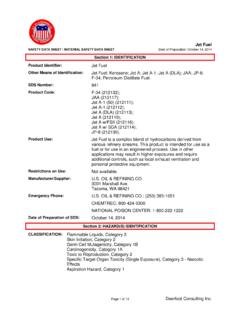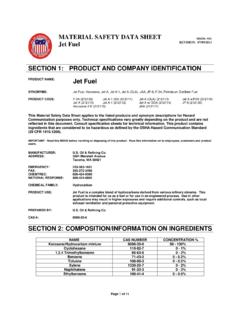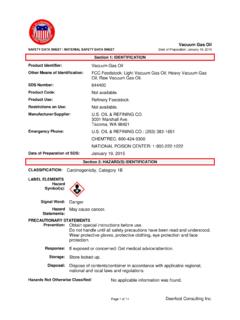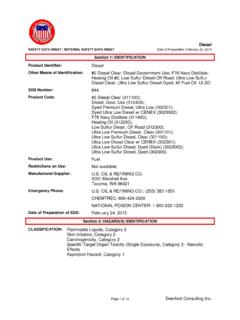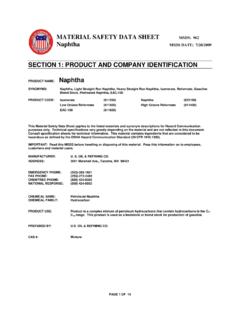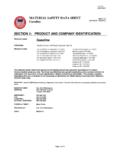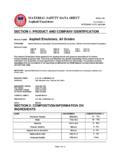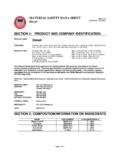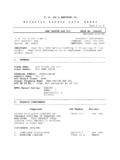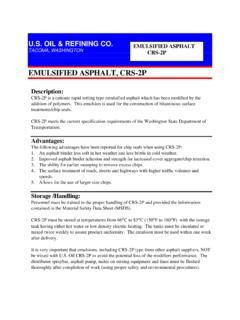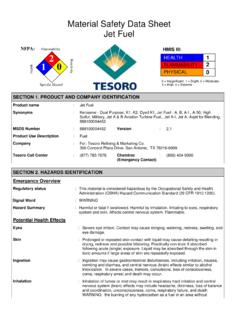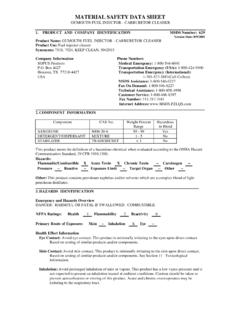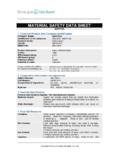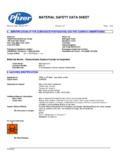Transcription of MATERIAL SAFETY DATA SHEET MSDS: 940 …
1 PAGE 1 OF 11 MATERIAL SAFETY data SHEET msds : 940 Residual fuel Oil REVISION: 12/18/2008 SECTION 1: PRODUCT AND COMPANY IDENTIFICATION PRODUCT NAME: Residual fuel Oil SYNONYMS: Residual fuel Oil, fuel Oil #6, Bunker C fuel Oil, IFO-30, IFO-100, IFO-120, IFO-180, IFO-240, IFO-280, IFO-320, IFO-380, IFO-500, IFO-600, IFO-700, ISO Marine Fuels PRODUCT CODE: Bunker C fuel Oil (422010) IFO-30 (422030) IFO-100 (422100) IFO-120 (422120) IFO-180 (422180) IFO-240 (422240) IFO-280 (422280) IFO-320 (422320) IFO-380 (422380) IFO-500 (422500) IFO-600 (422600) IFO-700 (422700) Generic Marine Fuels (429999)
2 This MATERIAL SAFETY data SHEET applies to the listed products and synonym descriptions for Hazard Communication purposes only. Technical specifications vary greatly depending on the product and are not reflected in this document. Consult specification sheets for technical information. This product contains ingredients that are considered to be hazardous as defined by the OSHA Hazard Communication Standard (29 CFR ). IMPORTANT: Read this msds before handling or disposing of this product. Pass this information on to employees, customers and product users. MANUFACTURER: U. S. OIL & REFINING CO. ADDRESS: 3001 Marshall Ave., Tacoma, WA 98421 EMERGENCY PHONE: (253)-383-1651 FAX PHONE: (253)-272-2495 CHEMTREC PHONE: (800) 424-9300 NATIONAL RESPONSE: (800) 424-8802 CHEMICAL NAME: Residual fuel Oil CHEMICAL FAMILY: Hydrocarbon PRODUCT USE: Residual fuel Oil is a complex blend of hydrocarbons derived from various refinery streams, usually residue, and can contain hydrogen sulfide and polycyclic aromatic hydrocarbons.
3 Typical streams include atmospheric tower bottoms and vacuum tower bottoms. The composition is complex and varies with the source of crude oil. This product is intended for us as a refinery feedstock, fuel or for use in an engineered process. Use in other applications may result in higher exposures and require additional controls, such as local exhaust ventilation and personal protective equipment. PREPARED BY: OIL & REFINING CO. CAS #: Mixture PAGE 2 OF 11 _____ SECTION 2: COMPOSITION/INFORMATION ON INGREDIENTS RESIDUAL fuel OIL CONSISTS OF DISTILLATES AND RESIDUAL FRACTIONS BLENDED TO PRESCRIBED VISCOSITY RANGES. THIS PRODUCT IS LIKELY TO CONTAIN TRACE AMOUNTS OF HYDROGEN SULFIDE.
4 Name CAS NUMBER CONCENTRATION % fuel Oil, Residual 68476-33-5 100% (Approx) SECTION 3: HAZARDS IDENTIFICATION Danger! This product may contain or release Hydrogen Sulfide a highly toxic, highly flammable gas which can be fatal if inhaled at certain concentrations. This product may also contain polycyclic aromatic oils which may be carcinogenic to humans. This product may cause irritation to eyes, skin and respiratory system. Avoid liquid, mist and vapor contact. Harmful or fatal if swallowed. Aspiration hazard, can enter lungs and cause damage.
5 May cause irritation or be harmful if inhaled or absorbed through the skin. Avoid prolonged or repeated skin contact. Contains polycyclic aromatic compounds which have been shown to cause anemia, disorders of the liver, bone marrow and lymphoid tissues in rats following dermal application. Combustible Liquid. Vapors may explode. May cause irritation to eyes, skin and respiratory system. Avoid liquid, mist and vapor contact. Harmful or fatal if swallowed. Aspiration hazard, can enter lungs and cause damage. May cause irritation or be harmful if inhaled or absorbed through the skin. CAUTION: This product is normally shipped hot and may cause burns to skin or eyes. PHYSICAL STATE: Liquid (Thick, Oily Liquid) ROUTES OF ENTRY: Dermal Contact.
6 Eye Contact. Inhalation. Ingestion. POTENTIAL HEALTH EFFECTS EYES: Hot MATERIAL can cause burns to the eyes. Eye irritation, tearing blurred vision may result from contact with liquid, mists and/or vapors. SKIN: Hot MATERIAL can cause burns to the skin. Contact may cause moderate irritation, de-fatting (cracking), redness, itching, inflammation, dermatitis and possible secondary infection. Repeated contact with components in this product may cause harmful effects in other parts of the body. INGESTION: May cause burns to mouth, throat and stomach. This product may cause nausea, vomiting, diarrhea and restlessness. DO NOT INDUCE VOMITING.
7 May cause harmful central nervous system effects, similar to those listed under "inhalation". INHALATION: Nasal and respiratory tract irritation, central nervous system effects including dizziness, drowsiness, blurred vision, fatigue, nausea, headache, loss of reflexes or loss of consciousness may occur. Hydrogen sulfide can evolve from this product, which can cause dizziness, nausea, headache or death. MEDICAL CONDITIONS GENERALLY AGGRAVATED BY EXPOSURE: Repeated or prolonged contact with spray or mist may produce chronic eye irritation and severe skin irritation. Repeated or prolonged exposure to spray or mist may produce respiratory tract irritation. This product may contain compounds that are possibly carcinogenic to humans.
8 OVER-EXPOSURE SIGNS/SYMPTOMS: Nasal and respiratory tract irritation, central nervous system effects including dizziness, drowsiness, blurred vision, fatigue, nausea, headache, loss of consciousness, respiratory arrest or sudden death could occur as a result of long term PAGE 3 OF 11 and/or high concentration exposure to vapors. See toxicological information (section 11) PAGE 4 OF 11 _____SECTION 4: FIRST AID MEASURES EYES: This product is normally stored and shipped hot (110 F to 200 F) and thermal burns are a risk. Flush immediately with large amounts of water for at least 15 minutes. Eyelids should be held away from the eyeball to ensure thorough rinsing. Seek medical advice if pain or redness continues.
9 SKIN: This product is normally stored and shipped hot (110 F to 200 F) and thermal burns are a risk. In case of contact, immediately flush skin with plenty of water. Remove contaminated clothing and shoes. Wash clothing before reuse. Clean shoes thoroughly before reuse. Get medical attention. Wash exposed area thoroughly with soap and water. Remove contaminated clothing promptly and launder before reuse. Contaminated leather goods should be discarded. If irritation persists or symptoms described in the msds develop, seek medical attention. INGESTION: This product may cause nausea, vomiting, diarrhea and restlessness. DO NOT INDUCE VOMITING. Seek prompt medical attention. INHALATION: If inhaled, remove to fresh air.
10 If breathing is difficult, give oxygen. If not breathing, give artificial respiration. Seek prompt medical attention if breathing is difficult or if not breathing. PAGE 5 OF 11 SECTION 5: FIRE-FIGHTING MEASURES FLAMMABILITY OF THE PRODUCT: Combustible FLAMMABLE LIMITS IN AIR, LOWER: Not Determined (% BY VOLUME): UPPER: Not Determined FLASH POINT: Closed Cup >60 C, (140 F) AUTOIGNITION TEMPERATURE: Approx 500 F PRODUCTS OF COMBUSTION: These products are carbon oxides (CO, CO2), nitrogen and sulfur oxides (NOX, SOX), particulate matter, VOC's. FIRE HAZARDS IN THE PRESENCE OF VARIOUS SUBSTANCES: When heated above the flash point, this MATERIAL will release vapors that can ignite when exposed to open flames, sparks and static discharge.
